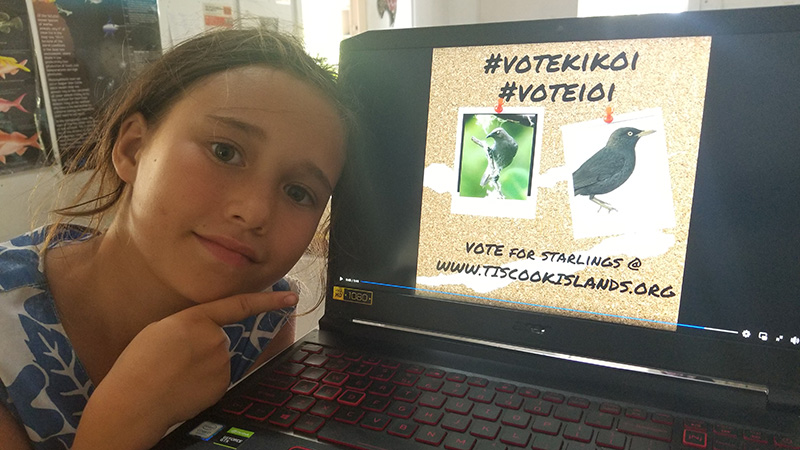Kīko’i the mysterious starling from Mauke
Saturday 6 November 2021 | Written by Te Ipukarea Society | Published in Environment, National

Ari George is the campaign manager for the extinct Kikoi and says 'Vote for Kikoi and I'oi' in Bird for the Year Cook Islands 2021. 21110525
Te Ipukarea Society’s Bird of the Year Cook Islands competition has a mysterious new entry this year. An extinct bird you may have never heard of, the Kīko’i or Mauke Starling (Aplonis mavornata), writes Te Ipukarea Society.
The Kiko’i was only ever found in the island of Mauke, meaning it is endemic to that one island. The last known recorded sighting of the Kikoi was in 1825 by a British visitor on the HMS Blonde, who also shot it while it was “hopping around on a tree”.
This specimen is now housed in the British Museum of Natural History and for a long time was called the ‘Mysterious Starling’ due to its unknown origin. At this time it was noted that rats were present in Mauke way back then, most likely having hitchiked with the first European ship that arrived two years prior. By 1973 no evidence of sightings of the Kīko’i could be found.
So why would you want to vote for an extinct bird for Bird of the Year Cook Islands?
Eight year old Ari George is the campaign manager for the Kīko’i and she says that “extinction sucks”.
She is not wrong. According to the International Union for the Conservation for Nature (IUCN) one in every eight birds face a high risk of extinction in the near future.
The Kīko’i is one of four known Cook Islands endemic birds which have sadly now been lost to history. Currently there are six endemic birds still alive, so we think it is pretty important to look after them.
Ari tells us that she wants “people to know more about the Kīko’i, so they can help protect the birds we still have alive”. The Kīko’i is closely related to the ‘Ī’oi or Rarotongan Starling which is also not well known and is considered ‘vulnerable’ on IUCN’s Red List.
Once very visible in the lowlands of Rarotonga, now you have to head to the hills to hear an ‘Ī’oi singing. Ari is hoping that people will also vote for ‘Ī’oi for Bird of the Year, to bring attention to this special bird, so it doesnt’ end up like the extinct Kīko’i.
Extinction indicates that something in the ecosystem is out of balance. Pre human times, the Pacific Islands did not have many natural predators such as cats, dogs, stoats and very few predatory birds such as owls or hawks. This means that our native birds would have flourished in this nurturing environment, until the arrival of humans and introduced species.
Now, predation from mammals, plus habitat loss through human impact are the constant daily battles for these birds. In Rarotonga, rat control has been undertaken in the Takitumu Conservation Area for several decades now, and has resulted in a noticeable improvement in bird numbers.
Rat eradication for the whole of Rarotonga, our largest island, would no doubt bring multiple benefits to some of our remaining native birds. But that is a huge task with many social, environmental, and logistical challenges, and may never happen.
In our discussions with the Pa Enua communities, rats are right up there in the list of concerns raised. TIS is now helping develop projects for rat eradication in several of our smaller islands including Mauke, Palmerston and Suwarrow.
You can share your voice for nature by voting for the TIS Bird of the Year Cook Islands 2021 by November 10 at www.tiscookislands.org.














































